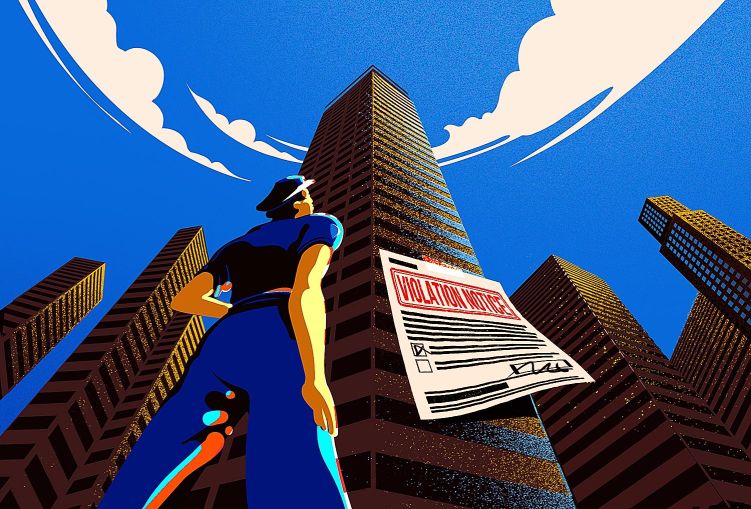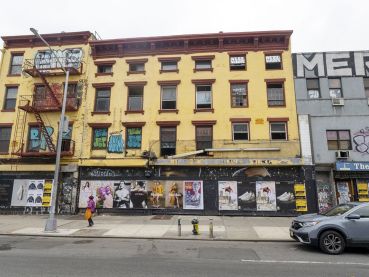Coming to Terms with the Beginning of Local Law 97
How owners of different types of buildings are coming to terms with New York’s new pollution rule
By Rebecca Baird-Remba January 16, 2024 1:00 pm
reprints
As New York City landlords face down their first full year having to comply with Local Law 97, the city’s carbon emissions reduction law, some landlords are rushing to figure out whether they’ll be able to comply. Others not so much.
Although the 2024 emissions targets should be easy for most buildings to meet, some owners will spend their two-year grace period before the city imposes fines deciding whether to pay them — or work a miracle and reduce their building’s energy usage by 2026. Local Law 97 aims to cut carbon emissions by 40 percent from most buildings of at least 25,000 square feet by 2030, and 80 percent by 2050. Rent-regulated housing, houses of worship and other kinds of affordable housing are exempt from the requirements. But city energy codes still require most owners of rent-restricted housing to make modest energy efficiency upgrades this year.
For the first two years in which Local Law 97 is in effect — 2024 and 2025 — building owners can get a break from meeting the new emissions benchmarks as long as they file plans with the city Department of Buildings showing how they plan to decarbonize their properties. Qualifying measures include installing more efficient heating and cooling systems, adding LED lights with sensors, and updating old facades and windows.
After filing initial reports in 2025, landlords have to show they are sticking to their plan and following through on retrofitting their properties. However, owners of industrial properties or buildings with energy-heavy occupants such as data centers, museums and large financial trading floors may have little choice but to pay the first round of fines, according to engineers.
“There are a few special buildings — data center-heavy buildings — that don’t have a pathway to complying with the law in 2025,” said Tristan Schwartzman, a principal at mechanical engineering firm Goldman Copeland Associates, who handles Local Law 97 retrofits. “Those spaces, I am not seeing them in a sprint to comply.”
Schwartzman added that the carbon impact of electricity will be discounted in the 2030 regulations, which might make it easier for buildings with power-hungry uses to one day comply — or at least keep their fines in check. An efficiently run data center would have a fine of around $10 per square foot under the 2025 benchmarks, he said. While there might be ways to reduce that fine, the building may never come into compliance with the law.
Landmarked buildings are also entitled to discounted fines, based on their owners’ inability to make certain energy upgrades.
“If you can demonstrate that your building has to use a certain amount of energy because it’s a landmark building, that can be discounted,” Schwartzman said. “Let’s say that a landmark building isn’t allowed to add louvers along the facade because it would ruin the aesthetic. They have to do mechanical cooling which costs 10 tons of CO2 a year, and then subtract that [from the fines and the benchmark]. It’s not going to completely eliminate their fines but maybe cut away 10 percent of their fines.”
Ultimately, he said that 98 percent of buildings in New York City should be able to comply with Local Law 97 from 2024 through 2030, and roughly 70 percent would be able to meet the 2030 emissions requirements.
Meanwhile, some engineers haven’t noticed their landlord clients rushing at all.
“The compliance targets outlined in LL97 and associated fines for noncompliance generally don’t justify the expense for deep retro-
fits — it is much cheaper to simply pay the fines,” said David Farnsworth, an engineer and principal at sustainable development firm Arup. He noted that most owners aren’t worried about meeting the 2024-2025 emissions limits. “The 2024 limits are quite easy for most buildings to meet, and the more aggressive, harder-to-meet targets don’t kick in until 2030.”
Scott Frank, a managing partner at mechanical engineering firm JB&B, pointed out that the depressed New York City office market of the past few years had not given commercial landlords a lot of revenue for necessary upgrades. However, some owners are trying to get in line with the requirements after dragging their feet for five years since lawmakers passed Local Law 97 in 2019.
“We’ve seen an uptick in activity,” Frank said. “This is not surprising, given the generally negative economic state of the real estate sector right now. But it also was anticipated, as the tendency of many owners is to wait to focus on issues like this in a ‘just-in-time’ manner. And, of course, there was a subset of the market that anticipated and hoped for legislative change that would eliminate the requirements of the law altogether.”
Gary Pomerantz, a mechanical engineer at construction consulting firm WSP, said he feels little sympathy for landlords who believe they won’t have to comply with Local Law 97 rules.
“There are some developers who really took it head on and said, ‘I’m going to comply,’” he said. “And there are some who said, ‘There’s gotta be a way not to do this,’ which is unfortunate.”
Pomerantz added that he’d heard every rumor and excuse that landlords have come up with about Local Law 97 retrofits. “There’s a lot of misinformation and disinformation out there, that our electric grid can’t handle it,” he explained. “But they’re going to upgrade it. People are saying it’s going to cost a fortune. Not necessarily, especially if you do it as a replacement for equipment that fails.”
One big, open question revolves around cogeneration plants, which are used by New York and Columbia universities on their campuses, by Consolidated Edison for steam generation, and by some commercial landlords to power their office buildings. Before Local Law 97 was passed, some developers built cogen plants — which burn natural gas to create electricity and heat — with the aim of reducing stress on the electric grid. However, Local Law 97 treats cogen plants as unsustainable, and the city has not found a solution for owners who already use them.
“They’re violating the goal of Local Law 97, which is don’t burn gas,” said Pomerantz. “Now [Columbia University] has this incredibly efficient Manhattanville campus based on the cogen plant. It’s going to take a little bit of thought.”
Con Ed relying on cogeneration for steam is a unique challenge because it supplies 11,000 buildings with millions of pounds of steam per hour — by burning natural gas.
“If everyone converts to electric, what happens to Con Ed steam?” asked Pomerantz. “Or how do they produce it without burning natural gas? If people get off Con Ed steam, they are going to impose a greater load on the electric grid.”
In the end, if owners really feel they cannot comply with Local Law 97, they will have to make a compelling hardship case to the Department of Buildings, which handles enforcement and rulemaking for the policy.
“If they truly can’t get there, I think then there will be a certain compromise to work out,” said Pomerantz. “But it’s going to be on the building to prove why they can’t meet the requirements. You’re going to have to prove that your building is so special, that it’s such a hardship. But I think that’s the rarity. I think most buildings can be dealt with. It’s time to get creative and work things out.”


